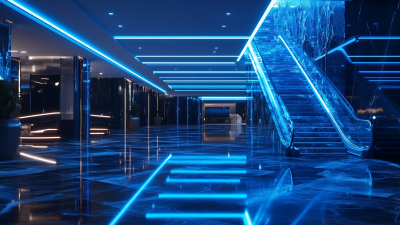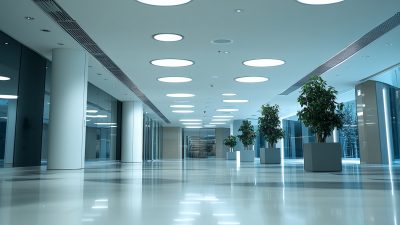
In today's commercial landscape, energy efficiency is not just a trend but a necessity, and optimizing Commercial Led Lighting plays a pivotal role in achieving this goal. As businesses strive to reduce operating costs and minimize their environmental footprint, the shift towards LED technology has become increasingly prominent. However, the mere installation of Commercial Led Lighting is only the first step; maximizing its efficiency involves a range of strategic practices and expert insights.

In this guide, we will explore seven expert tips designed to enhance the performance and effectiveness of your commercial lighting systems. By understanding how to properly implement and maintain these lighting solutions, businesses can not only improve illumination quality but also significantly lower energy consumption and costs, paving the way for a more sustainable future.
Smart LED control systems are transforming commercial lighting by enhancing energy efficiency and optimizing operational costs. According to a report by the U.S. Department of Energy, improved lighting controls can reduce energy usage by 20-30%. By leveraging technologies such as occupancy sensors, daylight harvesting, and programmable timers, businesses can significantly cut down their energy consumption. For instance, occupancy sensors automatically dim or turn off lights when spaces are unoccupied, resulting in substantial savings over time.
Furthermore, integrating smart controls with LED fixtures allows for real-time monitoring and data analytics, enabling companies to manage lighting more effectively. A study conducted by the American Council for an Energy-Efficient Economy found that facilities utilizing advanced lighting controls saw an average payback period of just 2.5 years on their investment. This swift return on investment, along with the potential for up to 50% energy savings compared to traditional systems, highlights the effectiveness of smart LED control systems in maximizing energy savings while promoting sustainability in commercial environments.
This bar chart illustrates the energy savings achieved by different commercial LED lighting strategies in relation to their implementation of smart control systems.
Proper LED fixture placement is crucial for maximizing the efficiency and effectiveness of commercial LED lighting. According to the U.S. Department of Energy, well-placed LED fixtures can enhance energy efficiency by up to 40%, significantly lowering operational costs. When fixtures are strategically installed, they not only improve light quality but also reduce the need for excessive lighting, which can lead to wasted energy and increased expenses.
Research by industry experts reveals that the placement of LED fixtures significantly influences the distribution of light in any space. For example, optimal mounting heights and angles can create a more uniform light distribution, reducing dark spots and improving visibility. This is particularly important in commercial settings where safety and productivity are paramount. With an estimated 25% of energy consumption in commercial buildings attributed to lighting, thoughtful fixture placement not only optimizes brightness but also plays a vital role in achieving sustainability goals.
Utilizing lighting sensors is crucial for enhancing the efficiency of commercial LED lighting systems. As the global ambient light sensor market is projected to grow from USD 3.39 billion in 2025 to approximately USD 7.99 billion by 2034, the integration of advanced sensor technology into lighting designs is gaining momentum. By employing intelligent environmental control systems similar to those used in modern plant factories, businesses can achieve optimal lighting conditions that not only reduce energy consumption but also enhance productivity.
The application of multi-sensor fusion techniques can significantly improve lighting efficiency by adapting to real-time environmental changes. For instance, utilizing adaptive algorithms that monitor occupancy and ambient conditions enables commercial spaces to automatically adjust lighting levels. This approach not only minimizes energy waste but also creates a more comfortable and productive environment for occupants. Leveraging these advanced technologies aligns with the growing trend towards smart building solutions that prioritize sustainability and operational efficiency. By integrating lighting sensors into commercial LED installations, businesses can benefit from reduced operational costs and improved overall performance.
 Tunable white technology is revolutionizing the way commercial spaces utilize LED lighting, providing significant enhancements in both efficiency and adaptability. This innovative approach allows businesses to adjust the color temperature of their lighting according to the specific needs of the environment and the time of day. For instance, cooler temperatures can invigorate and enhance productivity during working hours, while warmer shades promote relaxation and comfort in the evening. This flexibility not only optimizes the atmosphere but also contributes to energy savings by ensuring that the lighting is always aligned with the intended use of the space.
Tunable white technology is revolutionizing the way commercial spaces utilize LED lighting, providing significant enhancements in both efficiency and adaptability. This innovative approach allows businesses to adjust the color temperature of their lighting according to the specific needs of the environment and the time of day. For instance, cooler temperatures can invigorate and enhance productivity during working hours, while warmer shades promote relaxation and comfort in the evening. This flexibility not only optimizes the atmosphere but also contributes to energy savings by ensuring that the lighting is always aligned with the intended use of the space.
Incorporating tunable white technology into commercial LED lighting systems can lead to improved performance and reduced operational costs. By creating a dynamic lighting experience, businesses can enhance the well-being of employees and customers alike, contributing to heightened engagement and satisfaction. Moreover, intelligent control systems that leverage tunable white capabilities can further streamline energy use, allowing for automated adjustments based on occupancy or natural light availability. As companies continue to prioritize sustainability and efficiency, tunable white technology stands out as a key player in modern commercial lighting solutions.
Regular maintenance is crucial for maximizing the lifespan and efficiency of commercial LED lighting systems. One effective practice is to schedule routine inspections to check for any signs of damage or wear. This proactive approach helps identify issues before they escalate, ensuring that your lighting remains at optimal performance. During these inspections, ensure that fixtures are clean and free from dust accumulation, which can significantly diminish light output.
Another essential maintenance practice is to replace any burnt-out bulbs promptly. While LEDs typically have a longer lifespan than traditional bulbs, they can still fail over time. Keeping spare bulbs on hand can minimize downtime and maintain consistent lighting levels. In addition, consider monitoring the lighting for flickering or dimming, as these can indicate underlying issues that require immediate attention to prevent further inefficiencies.
Investing in a quality lighting control system is also beneficial. This allows you to adjust lighting based on occupancy or daylight levels, further enhancing energy efficiency. Regularly updating your control settings can ensure that your commercial space utilizes lighting in the most effective manner possible, ultimately reducing energy costs while extending the overall lifespan of your LED fixtures.







Let us help you get started with our superior LED lighting products.
Get all the latest news from BrightLED.
Copyright © Bright LED. All rights reserved.
STAY CONNECTED

